Abstract
This study examines who are the social actors in coordinating the environmental hot spots along the process of desalination. The integrated model design of life cycle modeling and Social Network Analysis is evaluated holistically by the inventory of life cycle and actor engagement ratings. Instances of the first small-scale reverse osmosis desalination plant project in Kelantan, Malaysia were used to meet the demands of this study. Environmental performance is measured through the Eco-Indicator 99 method in the Life Cycle Assessment Principles. Meanwhile, the network analysis of the actors’ networks involves stakeholders visualized through the UCINET software. The results show three hotspot points of membrane and brine disposal, the use of electrical energy, and the use of chemicals. The results acknowledged that 87 percent of the actors’ involvement from the dominant stakeholder group has been in control of the management and of the aforementioned hotspot. Undoubtedly, the results of this study can provide a better understanding of the potential market of actors to work with a more accurate and polycentric information flow for the development of more established desalination systems. This intriguing research will require further exploration in future studies.
1. Introduction
Climate changes, enforcement of the new law, development in water engineering, increased populations, as well as deterioration in the quality of clean water and water facilities are several factors that had an impact on the shift in managing clean water [,]. These situations have influenced local authorities to seek alternative water resources in meeting the demands of the issues that have emerged. One of the ideal options in managing clean water is through the seawater desalination process, due to high volume production, high quality, being safe, and being reliable. For example, membrane technology that involves reverse osmosis has been recognized as one of the sustainable aspects in the desalination industry [,]. According to the International Desalination Association (IDA) [], a total of 18,426 desalination plants have been developed until 2015 in 150 countries, which generate clean water at a capacity of 97.4 million cubic meters per day (m3/day). Since the introduction three decades ago, the development of the desalination plants has recorded over a 32-fold increase in global capacity [].
Nonetheless, the production of clean water from the desalination process has yielded numerous negative impacts on the environment. According to Asano et al. [], the demand for high energy and the release of pollutants and saltwater into nature have become primary obstacles for stakeholders to be continual in the industry. The evaluation of environmental performances on seawater desalination systems has been investigated over the years using the decision support approach [,,]. Some researchers have also used the Life Cycle Assessment (LCA) method, which involves “cradle-to-gate” or “gate-to-gate” approaches to study desalination systems [,,]. Results from these studies reveal short- and long-term effects of pollution due to desalination activities, such as salinity, chemical effluents, heavy metals, membranes, and fuel [,,]. Besides, the growing awareness among society on the advancement of desalination plants through wide dissemination of information could cause issues for the stakeholders.
The first establishment of a seawater desalination plant in Malaysia can be found in Bachok, Kelantan, which began operations in April 2018. Although the plant is developed at a small scale, local community believe that the desalination plan can solve the water crisis in the area that has lasted for 45 years. This Seawater Research Osmosis (SWRO) plant has a production capacity of 500,000 L/day or 20.8 m3 per hour in supplying freshwater to about 3000 residents. The operator for the plant has successfully coordinated the techno-economic aspect of the plant during the first year of operation. As a result, the level of intensity by stakeholders on this aspect has been investigated for the purpose of adaptability in a new SWRO plant at Senak. Nonetheless, in recent years, social and environmental aspects are emphasized continuously to meet the agenda of Sustainable Development Goal (SDG)-6 by 2030 [,]. Thus, a cross-disciplinary assessment has been suggested to investigate and address any environmental issues from the desalination plants. These issues could either be at the management and institutional level of the desalination system, such as structure, function, or capacity, or at a social level that involves stakeholders, social adaptation capability, and reciprocal institutional relationships.
Life Cycle Assessment (LCA) and Social Networking Analysis (SNA) are two approaches in research that have been used in numerous studies of the desalination process. The LCA approach is a method that categorizes and measures the potential environmental impact based on the input and output of the material through the use of 2007 ISO Standards []. However, LCA has limitations that usually involve incomprehensive understanding and perspective of the system for stakeholders in the social system. On the other hand, the Social Networking Analysis (SNA) method employs a qualitative graphical approach, which involves the construction of evaluation consensus, conflict analysis, potentials, and goals among the social agents within the field of social studies. The SNA method is considered to have more influence due to the outcomes that help decision-makers understand the changes, limitations, constraints, and choices of the organizational system, innovation, and technology [].
However, either LCA or SNA methods are unable to evaluate the SWRO plant in Senak because of insufficient data. Hence, a reciprocal integration of LCA and SNA is introduced to establish basic information of the SWRO system in Senak by applying a cross-sectional heuristic approach that integrates both fields of social and engineering sciences. This unified method is characterized by the ability to exploit implicit and explicit information, such as conflicts, interruptions, and disagreements, which have been omitted to a certain degree. Additionally, this heuristic integration of LCA and SNA can analyze the interaction between stakeholders (human) with the flow of materials, products, or SWRO management systems, as well as the impact of simulation measures and fundamental strategies within the SWRO management. In this study, the combined LCA and SNA methods examine the management of seawater desalination systems through the implementation of the reverse osmosis process. Based on the small community in Kampung Senak, this study has been carried out in three separate phases.
Indeed, this study is very relevant in providing empirical evidence of research and knowledge gaps on the pros and cons of plant existence for a long period of time in Senak. Therefore, there are at least two reasons that will explain the final findings of this study. First, the failure to consider the external determinants of plant adaptation capacity from outside the local and separate contexts. Adger et al. [] consider factors such as effectiveness, efficiency, equity, and legitimacy to be determinants to the successful adaptation of a desalination project. Second, the lack of scientific empirical studies that investigate the estimated environmental burden of desalination plants in the Malaysian context. This research can help in the preparation of the National Life Cycle Inventory database led by the Standard and Industrial Research Institute of Malaysia (SIRIM). Binder et al. [] also conclude that the consolidation of LCA decisions together with social science research is able to provide significant benefits to decision-makers to reduce the environmental impact of human activities.
2. Methods
Studies on the influence of stakeholders within the structure of the seawater desalination process had been considered complex by numerous researchers due to limited methods for investigation and the multiple perspectives that can be employed. Nonetheless, there would always be a need to establish the relationship between the information of desalination processes with the stakeholders such as scientists, government agencies, industry, non-governmental organizations, and society, for expansion of information within the industry. This study had adapted a study by Martino et al. [] that used a polycentric approach to examine the governance of phosphorus management through Material Flow Analysis (MFA) and Social Network Analysis (SNA) methods. The study had discussed extensively the need for a more robust research process that differs from pure and social sciences []. According to Quigley and Kuhne [], this method of research involved four stages, which are planning, action, observation, and reflection. The framework of this study involved two of the stages recommended. The first stage involved the evaluation of environmental loads triggered throughout the chain of desalination processes. The second stage examined the patterns that emerge from activities, socio-cultural relations, and socio-psychological relationships among the stakeholders involved. The flowchart for the integration of LCA and SNA methods can be observed in Figure 1.
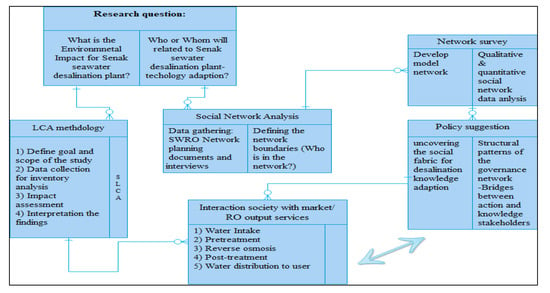
Figure 1.
Flowchart of the socio-technical framework for analysis in this study.
2.1. Life Cycle Assessment (LCA)
Based on the flowchart in Figure 1, the measurement of sustainability using the desalination process for products and services within the processing chain adhered to ISO 14040:2006 and ISO 14044:2006 standards. These standards outlined four necessary steps, which were goals and scope, inventory analysis, impact assessment, as well as interpretations []. The functional unit used for calculating the input and output of the life cycle for clean water from the initial phase of extraction of 50 m3 saltwater per hour with an energy consumption of 0.3 kWh/m3 was 1 m3 of desalinated water. The three phases in LCA were identified as (1) installation stage, (2) operation stage, and (3) post-installation stage, as shown in Figure 2. The SimaPro 8.5 software was used in this study as a majority of the data in the ecoinvent version 3.0 database complemented the mismatches and limitations of SWRO systems in Malaysia.
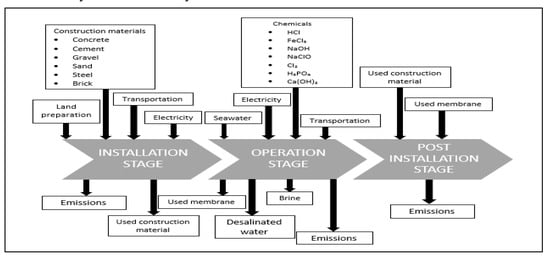
Figure 2.
System boundary of the seawater desalination plant in Senak.
Research Procedure of LCA
- Goals and scope: Determination of departure points from the three parts of the installation phase, operation stage, and post-installation stage have been set as the goal of this study. The boundary system measurement only involves “gate to gate” analysis.
- Inventory Analysis: Based on the compilation of most of the data from the “blue book”, the database from the input and output units of the material for each part of the system is developed as presented in Table 1.
 Table 1. Inventory of seawater desalination per m3 of desalinated water.
Table 1. Inventory of seawater desalination per m3 of desalinated water. - Impact Assessment: The calculation and characterization of various categories of effects in SimaPro is according to the methodology of Eco-indicator 99 []. The three main categories of damage that have been set in the software package are—Damage to Human Health, units index: Disability Adjusted Life Years (DALYs); Damage to Ecosystem Quality, units index: the loss of species over an certain area, during a certain time; Damage to Resources, units index: the surplus energy needed for future extractions of fossil fuels and minerals.
- Interpretation and uncertainty of the study: Detailed evaluation refers to the conclusion of the study that can help to identify hotspots along the product or process path in the Senak desalination plant. Furthermore, uncertainty and assumptions about emission factors and the dependence of generic emissions data extrapolated from foreign countries can be formulated as limitations in this study.
2.2. Social Network Analysis (SNA)
The SNA approach was an analysis that focused on the relationships between nodes or stakeholders in social networks using the graph theory [,,,]. This study had employed a qualitative method that involved ethnographic observation and interviews in examining the impact of the SWRO plant on the stakeholders and the community in Senak. A snowball sampling method was used, which resulted in 35 respondents interviewed through a set of semi-structured questions, as shown in Table 2. Due to the location of this plant, which was in a rural area, most of the interview sessions were conducted in the Malay language that addressed three core issues, which were (i) interest and attitude, (ii) knowledge and information, and (iii) power and interaction. Data collected was recorded using the NVivo software (QSE International). This study was conducted over six months, comprising data collection, copying, coding, and analysis based on the highlights of the primary and secondary literature. There were three different phases in collecting data for this study, which were (1) Phase 1: Pre-project, (2) Phase 2: SWRO system operation, and (3) Phase 3: Post-project. Data analysis using the SNA method involved five essential steps: (1) detailed data exploration in studying the input and output players of LCA inventory; (2) identifying the relationships and behaviors of the stakeholders within the seawater desalination system, with a value of 0 for no relationship and a value of 1 for an interaction between the stakeholder; (3) developing a binary matrix relationship with the stakeholders involved; (4) creating the social network image and attributions using the SNA UCINET software []; and (5) discussing the patterns and values of the data generated from NetDraw’s sociogram and application analysis.

Table 2.
List of initial contacts through the use of the snowball sampling method.
3. Results
3.1. SWRO Impact Analysis
The first phase of this study was the pre-project stage of planning and construction. An assessment of the load flow in the SWRO system was initiated using the Eco-indicator 99 (H) approach by quantifying according to the phases that represented a cradle-to-grave assessment before the SNA method was implemented []. There were two related outputs identified in this phase, which were the use of electricity and the use of petrol, as well as biodiesel fuels, in the removal and conveyance of materials or raw products. Figure 3 showed the impact of the resources due to reduction of minerals that contributed to the highest normalization impact with 2.7 × 10−2 pt, followed by the impacts of ecosystem quality and human health at 1.2 × 10−2 and 1.5 × 10−8 pt, respectively. According to Zevenhoven and Kilpinen [], the Volatile organic compounds (NWVOC) content in petrol and the formation of particulate material in biodiesel contributed to the destruction of troposphere ozone. The result also identified end-point (H) to impact the use of polyethene and concrete, which contributed to the highest impact of 84.6% with 2.3 × 10−2 pt. This result was highly observed in the vehicle operation activities and preliminary works, such as plant site preparation, excavation, and piping system operation, as shown in Figure 3. These findings were based on the perspective of individual hierarchy, which showed the importance of reducing negative environmental impact by using “surplus energy” and increasing the quality of current fossil fuels.

Figure 3.
Normalization during the construction phase.
The impact assessment in Phase 2 included the processes of seawater intake, pre-treatment execution, reverse osmosis implementation, and post-treatment application. Figure 4 shows the negative impact of all the materials used in the operation of the SWRO desalination process for all categories using a weighing scale. The deterioration in resources was recorded to be the highest impact at 53%, followed by human health and ecosystem quality at 45% and 2%, respectively. According to Mohamed and Sami [], the operation phase would be affected significantly, with nearly 100% of the impact observed in the life cycle system, primarily if the system was based on the electrical utilities.
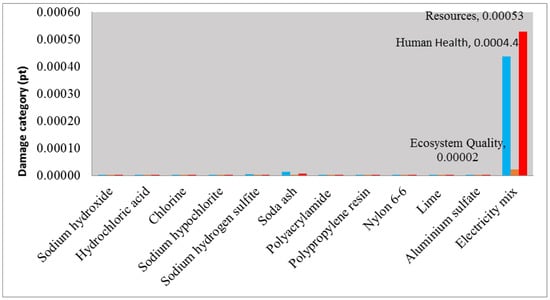
Figure 4.
Normalization during the operation phase.
Besides, electricity (96%) and chemicals consumption, such as hydrogen sulfide (1%) and soda ash (2%), were two significant contributors to the depreciation of the environment, as shown in Figure 4. A study by Biswas [] had proved that high electricity consumption used to operate the pump, membrane processes, and water distribution in a desalination plant contributed to about 92.1% of the Greenhouse gases (GHG) emission to the environment. The use of the electrical plant on the control panels for both the pump system and the reverse osmosis system to desalinate seawater required 3.27 kWh per m3 of power. This extreme consumption of electrical energy also included the feedback of the water level indicator with alarm, valve control, system performance, single pumps, as well as chemical pumps, among other operations that occurred in the desalination system. Nonetheless, by shifting to renewable energy sources, such as wind or solar energy from the existing electricity sources of Tenaga Nasional Berhad (TNB), this relatively high load of negative impact on the environment could be reduced by 35% to 50%. Moreover, Raluy et al. [,] also suggested that cogeneration, combined cycle, and internal combustion using fossil fuel sources could also potentially reduce the harmful impact by 35%.
The assessment of LCA that was carried out within the dismantling phase involved only the impact of water distribution activities, as shown in Figure 5. The complete activity lasted until the post-project stage, whereby water storage was excluded due to limitation of data and a significantly small quantity of output from the materials. The extent of damage to the environment was assessed using the normalization perspective, which recorded the highest result of 1.6 × 10−5 pt on the resource, followed by human health and quality of the ecosystems at 1.3 × 10−5 and 6.5 × 10−7 pt, respectively. The most significant sources of the emissions for these three contexts was the high electricity consumption, which this study assumed to be supplied 100% from fossil fuel. As reported in other studies, such as Blandin et al. and Zhenyuan et al. [,,], the overall impact on the environment was due to the use of electrical utilities from non-green resources, which produced the most significant load compared to other resources. Further investigations also revealed that the type of sources used in the desalination plant affected the overall damage of the environment. This critical factor had been identified in all three phases, with electricity consumption at 96%. Results from these analyses can be used as alternative data in developing strategies to address issues related to resolutions due to stress on the sustainability of mineral resources towards the effects of different metrics.
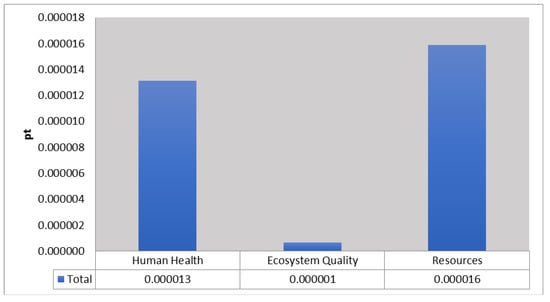
Figure 5.
Normalization during the water distribution phase.
3.2. Social Network Analysis at SWRO Institutions
Figure 6 displays the involvement of stakeholders in the management of the desalination plant system that was evaluated using the current social networks. The Ministry of Water, Land and Natural Resources (or the Ministry of W, L and NS/KATS), University Malaysia Terengganu (UMT), and Universiti Teknologi Malaysia (UTM) were the stakeholders identified to have the highest level of centrality values with significant connections to every phase (Phase 1, 2, and 3) of the hierarchical reduction within the SWRO plant. This result suggested that all three groups of stakeholders had access and information to operate and disseminate the knowledge of the contamination point in the system within this study. Numerous studies in the literature had explored the importance of the capacity for stakeholders to adapt to the establishment of desalination plants, both regionally and globally. The stakeholders can be categorized to several groups, such as "consumers", "workers", "local communities", "members of the value chain", "societies", and "institutions". However, local studies on the outcome of social interactions between stakeholders within SWRO plants are scarce.

Figure 6.
The degree of relationship between stakeholders in between compared to different phases throughout the implementation of the Seawater Research Osmosis (SWRO) project.
In this study, the concentration of the accumulated network based on the overall network density value was 42.3% in Phase 1, followed by Phases 2 and 3 at 21% and 34.6%, respectively. The relationship with the highest concentration of stakeholders in Phase 1 involved the federal, state, academic, and political institutions, with a total number of stakeholders and ties at 47 and 315, respectively. In contrast, Phase 2 only involved academic institutions and politicians. Phase 3 successfully identified that only academic institutions continued to maintain network relations with the community in Senak with a Quadratic Assignment Procedure (QAP) correlation of 0.835; p-value < 0.001. The result also showed that the academic institutions had been mediators for all phases (Phase 1, 2, and 3). Based on Figure 4, the frequency of engagement among stakeholders was not linear between each phase in the management within the SWRO plant. This finding indicated that the intensity of institutional involvement needs to be increased at the core of adaptation, which included external networking that would continuously change. On the other hand, the LCA method had yielded a slight impact, with the capacity output for seawater that was recorded in Phases 2 and 3 at 0.5 million liters per day (20.8 cubic meters per hour). This result suggested a minimal impact on encouraging or strengthening the relationship between institutions or stakeholders with the overall SWRO system.
3.3. Environmental Profile and Perspective
Table 2 shows the relationships between three essential variables towards the potential of Life Cycle Inventory (LCI) from the social perspective. These variables had been represented by the three core issues, which were (1) interest and attitude (Variable 1: V1), (2) knowledge and information (Variable 2: VII), and (3) power and interaction (Variable 3: VIII), as shown in Table 3. Choose your answer using the 1 to 5 scale, which are 1: Strongly negative/Strongly disagree, 2: Negative/Disagree, 3: Neutral, 4: Positive/Agree, 5: Strongly positive/Strongly agree.

Table 3.
Sample of interview questions.
Figure 7 shows the relationship being horizontally and linearly proportional with the density of the access score reported in percentages, which showed unsatisfactory results for all three variables. The percentage score for VI-a+VI-b was 55%, followed by VII-a+VII-b and VIII-a+VIII-b at 44% and 41%, respectively. These findings were confirmed through the correlation of approximately 0.82% of the contribution from non-uniformed participants of different demographic, academic, and occupational backgrounds. These differences had dominated all phases in this study. Therefore, networks related to social institutions should be strengthened at both “top-down” and “bottom-up” levels. Besides, stakeholders should also be made aware of the extensive consideration to the causal or dynamic interaction patterns that can enhance the understanding and the capacity to adapt to alternative strategies that can address the issue of high potential loads resulting from the SWRO system. Stakeholders would also be more responsible in realizing sustainable SWRO management.
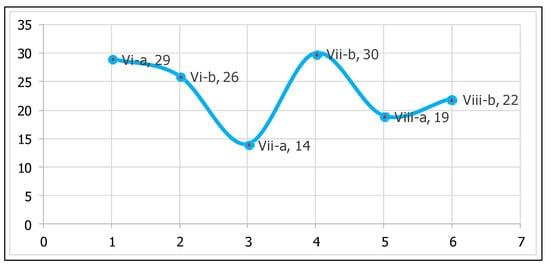
Figure 7.
Percentage score obtained from the Social Networking Analysis (SNA) variable test on Life Cycle Assessment (LCA) input–output data on the respondents of the study.
3.4. Towards Sustainability of the Desalination System
The operation in managing the materials, residues, products, loads, and reverse osmosis throughout the systems within the desalination plants had numerous cradle-to-grave challenges. Stakeholders need to upgrade the engagement processes and consultation practices to achieve maximum sustainability. This study revealed that the success rate in evaluating the effectiveness of the capacity to implement LCA in SWRO plants could be enhanced when stakeholders (5: community and NGOs, CBOs in Senak) were involved in all phases of adaptation from the existing desalination plants to the new or additional plants. The argument was based on the findings that showed stakeholders associated with any given local desalination plants had the most impact from adapting to the changing environment, socio-economic, and health. This finding supported results from Eckerberg and Joas, Adger et al., and Eakin et al. [,,]. However, this study asserted that the policy on energy, as well as the undefined factor at the ambiguity condition of the seawater involved in the desalination process, can be difficult to interpret from a micro, meso, or mezzo perspective. These issues would, therefore, influence the fundamental aspects in managing the operations in SWRO plants, such as seawater production and extraction, brine disposal, construction, energy installation, tax and license for import and export, as well as rates for water usage and subsidies. Hence, the knowledge of the implications involved in managing and operating a desalination system should be promoted more consistently and transparently.
Figure 8 shows the Dolphin Echolocation Optimization (DEO) diagram according to the hierarchy of stakeholders and the intercorrelated networks between stakeholders at Levels 1, 2, 3, 4, and 5, with the respective participation at different levels. From the perspective of LCA, the impact of desalination processes could be firmly supported by stakeholders within the fourth level of the hierarchical structure. Hence, this level of stakeholders needed to develop relationships with stakeholders from the second, third, and fifth level of the hierarchical structure to provide information. Besides, the quality and quantity criteria of the stakeholders involved were crucial in developing a strategic framework to manage clean water from desalination plants []. Hence, each group of stakeholders should be competent in the field of engineering and environmental science to understand the desalination process and address the social policy and economic issues involved. The constraints on the availability and use of inventory data in Malaysia must also be improved to be less dependent on ecoinvent version 3 databases from other countries. The integration of the institutional networks between the stakeholders at Levels 1, 2, 3, 4, and 5 can significantly promote SDGs within the management at the SWRO system in Senak. Further studies can potentially enhance the issues found within the field of studies, such as the frameworks for water consumption at the institutional sector, legitimacies, programs, administrations, subsidies, rates for water, and knowledge within the communities.
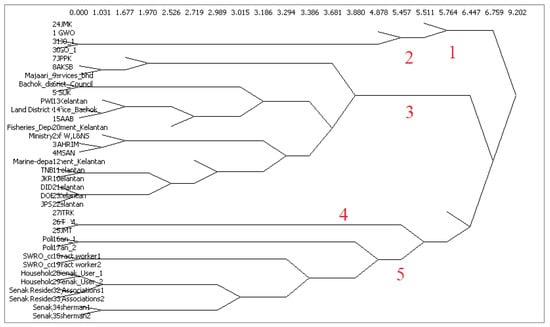
Figure 8.
A tree diagram of different stakeholders in the management of a SWRO desalination project.
4. Conclusions
The evaluation process using the integration of LCA and SNA methods has been highly effective in this study, which presented the authentic relationships within the management of the desalination system that affect the environment. Based on the results from this study that has been carried out for six months using polycentric tracking of the stakeholders, it has revealed an insight into the inputs and outputs produced by SWRO. This study indicates that external and internal determinant factors that are previously isolated, without denying the gap that exists in the acquisition of current and prior inventory bases for both LCA and SNA, has achieved a 91% success rate. Both crucial contributions from the findings of LCA and the SNA are raised through social and institutional integration of the SWRO process, where adaptability is expected for the ongoing maintenance of the SWRO plant in Senak. Findings from this study highlight the two approaches used as a viable solution in improving the effectiveness of SWRO governance for future sustainability. Based on the findings of this study, further research conducted by several researchers [,,,,] using the Social Life Cycle Assessment (SLCA) or Exergetic Life Cycle Assessment (ELCA) approach can fill the knowledge gap in the context of social, economic, and environmental effects that may be considered as a limitation in this study.
Author Contributions
L.A.G. contributed to conceptualization, formal analysis, investigation, methodology, LCA software analysis, visualization, writing-original draft, writing-review and editing. I.S.N., N.A. and M.M.H. contributed to funding acquisition, resources, supervision, and validation. All authors have read and agreed to the published version of the manuscript.
Funding
This research received no external funding.
Acknowledgments
The authors would like to thank Ministry of Higher Education on the initiative funding to the development of SWRO under Translational Research Project and the Universiti Malaysia Terengganu; Transdisciplinary Research Grant (TRGS): vote 53241 for supporting this project.
Conflicts of Interest
The authors declare no conflict of interest.
Abbreviations
CBO: Community Based Organisation; DID: Department of Irrigation and Drainage; DOE: Department of Environment; DEO diagram: Dolphin Echolocation Optimization diagram; GWO: Global Water Organization pt: Eco-indicator point (Pt) units; JPPK: Federal Development Department of Kelantan; JKR: Malaysian Public Works Department; Ministry of W, Land NS: Ministry of Water, Land and Natural Resources; NAHRIM: MTRK: The Kelantan People’s Action Council; National Hydraulic Research Institute of Malaysia; NGO: Non-Governmental Organisation; PAAB: Pengurusan Aset Air Berhad; PWD: Public Works Department; MSAN: Majlis Sumber Air Negara; NWVOC: Volatile organic compounds emissions from gasoline and diesel powered vehicle; SWRO: Seawater Research Osmosis; SDG-6: Sustainable Development Goals (SDGs); SUK: Kelantan State Government Secretary’s; TNB: Tenaga Nasional Berhad; UMT: UniversitI Malaysia Terengganu; UTM: Universiti Teknologi Malaysia
References
- Rygaard, M.; Binning, P.J.; Albrechtsen, H.-J. Increasing urban water self-sufficiency: New era, new challenges. J. Environ. Manag. 2011, 92, 185–194. [Google Scholar] [CrossRef] [PubMed]
- Grant, S.B.; Saphores, J.D.; Feldman, D.L.; Hamilton, A.J.; Fletcher, T.D.; Cook, P.; Stewardson, M.J.; Sanders, B.F.; Levin, L.A.; Ambrose, R.F.; et al. Taking the "waste" out of "wastewater" for human water security and ecosystem sustainability. Science 2012, 337, 681–686. [Google Scholar] [CrossRef] [PubMed]
- Greenlee, L.F.; Lawler, D.; Freeman, B.D.; Marrot, B.; Moulin, P. Reverse osmosis desalination: Water sources, technology, and today’s challenges. Water Res. 2009, 43, 2317–2348. [Google Scholar] [CrossRef] [PubMed]
- Lee, K.P.; Arnot, T.; Mattia, D. A review of reverse osmosis membrane materials for desalination—Development to date and future potential. J. Membr. Sci. 2011, 370, 1–22. [Google Scholar] [CrossRef]
- International Desalination Association (IDA). Desalination by Numbers. 2018. Available online: http://idadesal.org/desalination-101/desalination-by-the-numbers/ (accessed on 6 March 2018).
- Raluy, R.; Serra, L.; Uche, J. Life cycle assessment of MSF, MED and RO desalination technologies. Energy 2006, 31, 2361–2372. [Google Scholar] [CrossRef]
- Asano, T.; Burton, F.; Leverenz, H.; Tsuchihashi, R.; Tchobanoglous, G. Water Reuse: Issues, Technologies, and Applications; McGraw-Hill: New York, NY, USA, 2007. [Google Scholar]
- Zhou, J.; Chang, V.W.C.; Fane, A.G. Environmental life cycle assessment of reverse osmosis desalination: The influence of different life cycle impact assessment methods on the characterization results. Desalination 2011, 283, 227–236. [Google Scholar] [CrossRef]
- Coday, B.D.; Miller-Robbie, L.; Beaudry, E.G.; Munakata-Marr, J.; Cath, T.Y. Life cycle and economic assessments of engineered osmosis and osmotic dilution for desalination of Haynesville shale pit water. Desalination 2015, 369, 188–200. [Google Scholar] [CrossRef]
- Kim, J.E.; Phuntsho, S.; Chekli, L.; Choi, J.Y.; Shon, H.K. Environmental and economic assessment of hybrid FO-RO/NF system with selected inorganic draw solutes for the treatment of mine impaired water. Desalination 2018, 429, 96–104. [Google Scholar] [CrossRef]
- Vince, F.; Aoustin, E.; Bréant, P.; Maréchal, F. LCA tool for the environmental evaluation of potable water production. Desalination 2008, 220, 37–56. [Google Scholar] [CrossRef]
- Lattemann, S.; Höpner, T. Environmental impact and impact assessment of seawater desalination. Desalination 2008, 220, 1–15. [Google Scholar] [CrossRef]
- Biswas, W.K. Life cycle assessment of seawater desalinization in Western Australia. Int. J. Environ. Chem. Ecol. Geol. Geophys. Eng. 2009, 3, 231–237. [Google Scholar]
- Marini, M.; Palomba, C.; Rizzi, P.; Casti, E.; Marcia, A.; Paderi, M. A multicriteria analysis method as decision-making tool for sustainable desalination: The Asinara Island case study. Desalination Water Treat. 2017, 61, 274–283. [Google Scholar] [CrossRef]
- Ibrahim, Y.; Arafat, H.A.; Mezher, T.; Almarzooqi, F. An integrated framework for sustainability assessment of seawater desalination. Desalination 2018, 447, 1–17. [Google Scholar] [CrossRef]
- Alhaj, M.A.; Al-Ghamdi, S.G. Integrating concentrated solar power with seawater desalination technologies: A multi-regional environmental assessment. Environ. Res. Lett. 2019, 14, 074014. [Google Scholar] [CrossRef]
- Bhaduri, A.; Bogardi, J.; Siddiqi, A.; Voigt, H.; Vörösmarty, C.; Pahl-Wostl, C.; Bunn, S.E.; Shrivastava, P.; Lawford, R.; Foster, S.; et al. Achieving sustainable development goals from a water perspective. Front. Environ. Sci. 2016, 4, 1–13. [Google Scholar] [CrossRef]
- Karnib, A. Water as Crosscutting Factor in the SDGs Under Review at the High-Level Panel Forum for Sustainable Development (HLPF) 2019 in the Arab States. UNESCO WWAP Consultant. In Proceedings of the UNESCO World Water Assessment Programme (WWAP), New York, NY, USA, 11 July 2019. [Google Scholar]
- Khasreen, M.M.; Banfill, P.; Menzies, G.F. Life-Cycle assessment and the environmental impact of buildings: A review. Sustainability 2009, 1, 674–701. [Google Scholar] [CrossRef]
- Binder, C.R. From material flow analysis to material flow management Part I: Social sciences modeling approaches coupled to MFA. J. Clean. Prod. 2007, 15, 1596–1604. [Google Scholar] [CrossRef]
- Adger, W.N.; Brown, K.; Tompkins, E.L. The political economy of cross-scale networks in resource co-management. Ecol. Soc. 2005, 10, 9. [Google Scholar] [CrossRef]
- Martino, S.; Tett, P.; Kenter, J.O. The interplay between economics, legislative power and social influence examined through a social-ecological framework for marine ecosystems services. Sci. Total. Environ. 2019, 651, 1388–1404. [Google Scholar] [CrossRef]
- Bradbury-Huang, H. What is good Action Research? Why the resurgent interest? Action Res. 2010, 8, 93–109. [Google Scholar] [CrossRef]
- Quigley, B.A.; Kuhne, G.W. Understanding and using action research in practice settings. In Creating Practical Knowledge Through Action Research: Posing Problems and Improving Practice; Quigley, B.A., Kuhne, G.W., Eds.; New Directions for Teaching and Learning; Jossey-Bass: San Francisco, CA, USA, 1997; Volume 73, pp. 23–40. [Google Scholar]
- Goedkoop, M.J.; Spriensma, R. The Eco-Indicator 99, a Damage Oriented Method for Life Cycle Impact Assessment Methodology Report; PRé Consultants B.V.: Amersfoort, The Netherlands, 2001. [Google Scholar]
- Kamble, S.; Singh, A.; Kazmi, A.; Starkl, M. Environmental and economic performance evaluation of municipal wastewater treatment plants in India: A life cycle approach. Water Sci. Technol. 2019, 79, 1102–1112. [Google Scholar] [CrossRef] [PubMed]
- Hanneman, R.; Riddle, M. Introduction to Social Network Methods. Online textbook. 2005. Available online: https://www.faculty.ucr.edu/~hanneman/nettext/ (accessed on 7 March 2018).
- Everett, M.G.; Borgatti, S.P. Extanding centrality. In Model and Methods in Social Network Analysis; Carrington, S.W., Ed.; Cambridge University Press: New York, NY, USA, 2005; pp. 57–63. [Google Scholar]
- Parise, S. Knowledge management and human resource development: An application in social network analysis methods. Adv. Dev. Hum. Resour. 2007, 9, 359–383. [Google Scholar] [CrossRef]
- Scott, J.; Carrington, P.J. Introduction. In The Sage Handbook of Social Network Analysis; Scott, J., Carrington, P.J., Eds.; Sage: Thousand Oaks, CA, USA, 2011; pp. 1–8. [Google Scholar]
- Borgatti, S.P.; Everett, M.G.; Freeman, L.C. Ucinet for Windows: Software for Social Network Analysis; Analytic Technologies: Harvard, MA, USA, 2002. [Google Scholar]
- Jijakli, K.; Arafat, H.A.; Kennedy, S.; Mande, P.; Theeyattuparampil, V.V. How green solar desalination really is? Environmental assessment using life-cycle analysis (LCA) approach. Desalination 2012, 287, 123–131. [Google Scholar] [CrossRef]
- Zevenhoven, R.; Kilpinen, P. Control of Pollutants in Flue Gases and Fuel Gases, Research Report, 2004, Helsinki University of Technology. Available online: https://www.hut.fi/~rzevenho/gasbook (accessed on 2 May 2019).
- Raluy, R.; Serra, L.; Uche, J. Life cycle assessment of desalination technologies integrated with renewable energies. Desalination 2005, 183, 81–93. [Google Scholar] [CrossRef]
- Raluy, R.; Serra, L.; Uche, J. Life cycle assessment of water production technologies—Part 1: Life cycle assessment of different commercial desalination technologies (MSF, MED, RO) (9 pp). Int. J. Life Cycle Assess. 2004, 10, 285–293. [Google Scholar] [CrossRef]
- Blandin, G.; Verliefde, A.R.; Tang, C.Y.; Le-Clech, P. Opportunities to reach economic sustainability in forward osmosis–reverse osmosis hybrids for seawater desalination. Desalination 2015, 363, 26–36. [Google Scholar] [CrossRef]
- Zhenyuan, X.; Lenan, Z.; Lin, Z. Ultrahigh-efficiency desalination via a thermally-localised multistage solar still. Energy Environ. Sci. 2020, 13, 830–839. [Google Scholar]
- Eckerberg, K.; Joas, M. Multi-level Environmental Governance: A concept under stress? Local Environ. 2004, 9, 405–412. [Google Scholar] [CrossRef]
- Adger, W.N.; Dessai, S.; Goulden, M.; Hulme, M.; Lorenzoni, I.; Nelson, D.R.; Naess, L.O.; Wolf, J.; Wreford, A. Are there social limits to adaptation to climate change? Clim. Chang. 2008, 93, 335–354. [Google Scholar] [CrossRef]
- Eakin, H.; Lerner, A.M.; Manuel-Navarrete, D.; Aguilar, B.H.; Martínez-Canedo, A.; Tellman, B.; Charli-Joseph, L.; Álvarez, R.F.; Bojórquez-Tapia, L.A. Adapting to risk and perpetuating poverty: Household’s strategies for managing flood risk and water scarcity in Mexico City. Environ. Sci. Policy 2016, 66, 324–333. [Google Scholar] [CrossRef]
- Schiffler, M. Perspectives and challenges for desalination in the 21st century. Desalination 2004, 165, 1–9. [Google Scholar]
- Macombe, C.; Leskinen, P.; Feschet, P.; Antikainen, R. Social life cycle assessment of biodiesel production at three levels: A literature review and development needs. J. Clean. Prod. 2013, 52, 205–216. [Google Scholar] [CrossRef]
- Musaazi, M.K.; Mechtenberg, A.R.; Nakibuule, J.; Sensenig, R.; Miyingo, E.; Makanda, J.V.; Hakimian, A.; Eckelman, M.J. Quantification of social equity in life cycle assessment for increased sustainable production of sanitary products in Uganda. J. Clean. Prod. 2015, 96, 569–579. [Google Scholar] [CrossRef]
- Francisco, B.F.; Antonio, L.G.; María Belén, M.M. Requirements for the construction of new desalination plants into a framework of sustainability. Sustainability 2020, 12, 5124. [Google Scholar]
- Georgios, A.T.; Gijsbert, K. Social Life Cycle Assessment of Brine Treatment in the Process Industry: A consequential approach case study. Sustainability 2019, 11, 5945. [Google Scholar]
© 2020 by the authors. Licensee MDPI, Basel, Switzerland. This article is an open access article distributed under the terms and conditions of the Creative Commons Attribution (CC BY) license (http://creativecommons.org/licenses/by/4.0/).